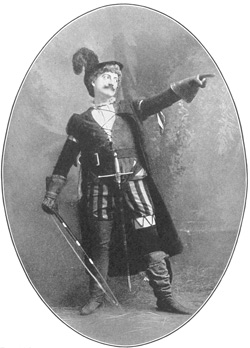 The Cleveland Press, part of the Cleveland State University Library, has an incredible photographic archive of Shakespeare in performance, and browsing through their collection was part of what piqued my curiosity in this heretofore unconsidered facet of Shakespeare. The oldest photograph which the Cleveland Press has is of stage actor Lawrence Barrett as Cassius in an 1870 production of Julius Caesar.
The Cleveland Press, part of the Cleveland State University Library, has an incredible photographic archive of Shakespeare in performance, and browsing through their collection was part of what piqued my curiosity in this heretofore unconsidered facet of Shakespeare. The oldest photograph which the Cleveland Press has is of stage actor Lawrence Barrett as Cassius in an 1870 production of Julius Caesar.
Barrett, looking very Roman as Cassius.
Looking at this photo led me down a new path of investigation, when I read that Barrett starred in this particular show alongside fellow actor Edwin Booth as Brutus. Now, Booth was perhaps the most famous Shakespearean actor of the nineteenth century. One of the biggest stars of his day, he was famous for his Hamlet, Richard III, and Shylock. Unbelievably, a wax cylinder recording of him performing Othello survives. Although the sound quality is poor, it’s spine tingling to hear this voice speaking from over a hundred years in the past, utilizing Shakespeare as the medium to reach across the intervening century.
Edwin Booth as Hamlet.
Edwin not only became famous as a player of Shakespeare but also became infamous as the older brother of John Wilkes Booth. That’s right – that’s the John Wilkes Booth, the assassin of President Abraham Lincoln. In fact, John Wilkes himself had appeared onstage several times before his most famous performance at Ford’s Theatre. Only that previous fall of 1864, he, Edwin, and their  brother Junius had acted together in Julius Caesar as Marc Antony, Brutus, and Cassius, respectively. Edwin disowned his brother after the assassination and was himself forced to retire from the public eye for several months. It did not incur any lasting damage to his reputation, however, as he is still lauded and respected today as a master of the theatre.
brother Junius had acted together in Julius Caesar as Marc Antony, Brutus, and Cassius, respectively. Edwin disowned his brother after the assassination and was himself forced to retire from the public eye for several months. It did not incur any lasting damage to his reputation, however, as he is still lauded and respected today as a master of the theatre.
The brothers Booth: John, Junius, and Edwin in Julius Caesar.
The Cleveland Press collection also contains a photograph of Sarah Bernhardt, possibly the most famous female actress of the nineteenth century.
The glamorous Bernhardt as Cleopatra in Antony and Cleopatra, around 1890.
This compelling picture spurred me on to learn that Bernhardt later made her film debut in 1900 in Le Duel d’Hamlet, a brief two minute reel of Hamlet’s duel with Laertes in which she played the title role. This is believed to be first ever film adaptation of that play, and it is also noted for utilizing the new innovation of playing pre-recorded cylinders of the actor’s voices and sound effects along with the film. The entire film may be seen here, unfortunately without the soundtrack, which has been lost.
Drew strutting his stuff as Petruchio.
Or check out this dapper fellow, John Drew, Jr., another famous nineteenth century Shakespearean specialist. Drew came from a family of actors and is the uncle of John, Ethel, and Lionel Barrymore. This also means that he’s the great-great uncle of Drew Barrymore.
All of the photos in this collection are like breadcrumbs leading down a trail of interesting discoveries, as I realized once I began browsing through them. Each one uncovers all new stories of Shakespeare and the actors who have brought his words to life over the centuries. The costumes are so elaborate and the expressions so vivid that there is an instant connection across time, making the viewer regret not being able to see these theatrical giants in action. It is impossible not to look at a photograph without wanting to find out a little bit more about that actor, to imagine how they were celebrities in their own time and how their work is still influencing performances of Shakespeare today. For it is not just that Shakespeare of the Elizabethan theatre who has informed how his works are produced in the twenty-first century, but rather a series of building blocks of trends and innovations resting on the shoulders of these men and women and those who came before them.
Natalie A.



Hi there to every one, the contents present at this web page are actually amazing for people knowledge, well, keep up the good work fellows.
ReplyDeleteHyperlink function in excel
Appreciating the persistence you put into your blog and detailed information you provide.
ReplyDelete--------------
Read in Hebrew
This video post is actually great, the noise quality and the picture quality of this tape post is genuinely amazing. Lego for kids
ReplyDeleteI really like and appreciate your blog post, thanks again. Want some more stuff.
ReplyDeleteMy Room Rent
I really like and appreciate your blog post, thanks again. Want some more stuff.
ReplyDeleteMy Room Rent